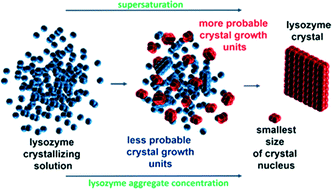Abstract
The aggregation of lysozyme in crystallizing solutions prior to crystal nucleation and during crystal growth has been the subject of numerous investigations over the past two decades. Nevertheless, it remains a controversial rather than a well-recognized phenomenon. In this study, we investigate the growth of tetragonal lysozyme crystals in quiescent solutions at the early crystal growth stage using seven different protein concentrations ranging from 25 mg ml−1 to 55 mg ml−1, 5% NaCl (w/v), 0.1 M sodium acetate buffer (pH 4.0), and constant temperature (22.0 °C). The growth rates of lysozyme crystals are determined by analyzing the time-lapse images of the evolving visible crystal area, recorded at relatively high magnification (600×). The calculated crystal growth rates are then analyzed according to an equilibrium distribution of lysozyme aggregates, which is based on a model two-body process (monomer ↔ dimer ↔ tetramer ↔ octamer ↔ hexadecamer) developed by M. Li et al. (1995). All types of aggregates are considered separately. We found that both octamers and tetramers are probable candidates for crystal growth units and suggested the most voluminous aggregate fraction as strongly influencing the crystal growth process. We also interpret the lysozyme crystal nucleation in the frame of the classical nucleation theory (CNT) and in accordance with the assumed two-body aggregation reaction set. Our results reveal that the tetramer appears to be the least achievable nucleus size across the whole protein concentration range, where classical nucleation could still be an observable phenomenon.


 Please wait while we load your content...
Please wait while we load your content...